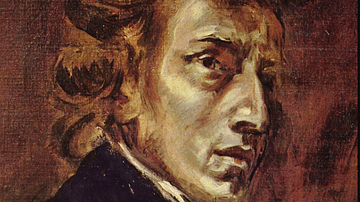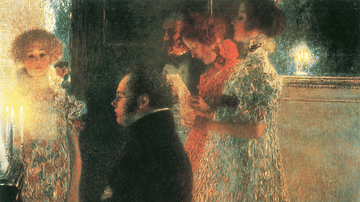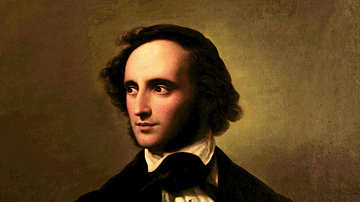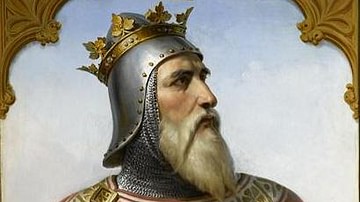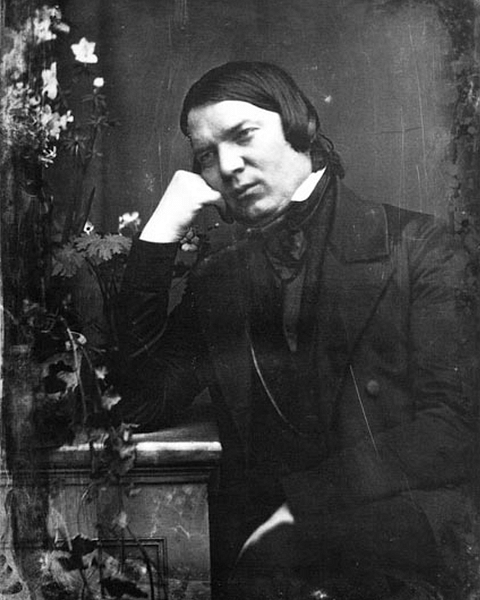
Robert Schumann (1810-1856) was a German composer of Romantic music, particularly piano and orchestral works, as well as over 250 songs or lieder. He was also a musical critic and founded his own magazine. His wife Clara Schumann (1819-1896), a concert pianist and composer of renown in her own right, inspired Robert to attempt larger-scale works such as symphonies.
Schumann's work was not especially popular in his own lifetime, and he was continuously troubled by the spectre of mental illness. He attempted suicide, and, suffering from hallucinations, he ended his days in an asylum. Robert Schumann is today considered one of the greatest exponents of Romantic music, where emphasis is given to personal artistic expression and experimentation, often with inspiration coming from art, literature, and nature.
Early Life
Robert Schumann was born in Zwickau, Saxony, on 8 June 1810. His father, August Schumann, was a bookseller, but his interest went far deeper than merely selling literature, for he translated into German the complete works of Lord Byron (1788-1822) and Walter Scott (1771-1832). This perhaps explains Robert's life-long passion for literature, especially the work of Romantic writers like Jean Paul Richter (1763-1825), his personal favourite. Robert studied at the Zwickau Lyceum in an uneventful youth in terms of academic achievement.
Robert's life turned upside down when his father died in 1826 after suffering some sort of inner mental turmoil. There was further family tragedy when Robert's sister Emilie, who had also been troubled by mental problems, committed suicide. Robert thereafter lived in perpetual fear that he, too, would one day succumb to such an illness. Spoilt by his mother, Robert was "allowed to indulge in such expensive tastes as champagne and cigars while still at school" (Arnold, 1647). Robert had written his own music while still a child, and his skills merited taking private piano lessons in Leipzig where he also studied law from 1828. Unsettled in his studies – it was his mother who had pushed for him to study law – Robert moved on to the University of Heidelberg in 1829. Still not impressing his tutors and still showing little interest in law, which he described as "chilly jurisprudence with its ice-cold definitions", Robert decided to go on a grand tour to see the cultural sights of Switzerland and Italy (Steen, 400).
Schumann did not particularly impress with his piano playing. His hopes of becoming a concert pianist were, in any case, dashed early on in a bizarre accident involving a device he himself designed to strengthen his fingers. That is, at least, the traditional view. Some more modern historians present the theory that the injury came about as a result of a mercury treatment for syphilis (which is noted in his medical records). Whatever the real cause, Schumann certainly suffered a debilitating and permanent hand injury. Instead, then, Schumann turned to music criticism and creating his own compositions. Here he was to have much more success. At last, he had found his vocation. As Schumann himself remarked on completing his first compositions: "On sleepless nights I am conscious of a mission which rises before me like a distant peak" (Schonberg, 182).
Character
Schumann was taciturn, hypersensitive, and prone to mood swings. He himself once classified his character as having two opposing aspects: "Florestan (extrovert and impetuous) and Eusebius (dreamy, melancholic, introverted)", which equated with his two sides as a man of action and a dreamer (Wade-Matthews, 362). The music historian H. C. Schonberg gives the following summary of Schumann's character and appearance:
A quiet man, medium-sized, with a sensitive face and lips that were always pursed as though he were whistling to himself…Big-hearted, generous, dedicated, in love with music, he lent a helping hand to all young talent.
(179)
Composing Style
Schumann was frequently inspired by works of literature. Indeed, one of his earliest compositions for piano, Papillons (Butterflies), published in 1832, was inspired by a novel by Jean Paul. Other sources of inspiration came from the great composers who had come before him. Schumann insisted on playing at least one piece every day composed by Johann Sebastian Bach (1685-1750). Schumann was also an admirer of the sensational violinist Niccolò Paganini (1782-1840) whom he describes as "the turning point in the history of virtuosity" (Wade-Matthews, 355).
The New Oxford Companion to Music gives the following assessment of Schumann's composing style:
His piano writing style is extremely individual, using the sustaining pedal and the middle range of the instrument to make a sensuous, rather brilliant sound.
(1647)

Schumann was particularly interested in not only charming the ears of his listeners but also in creating memorable images in their minds. He once noted that "the more special a work is, the more individual pictures it spreads before the listener, and the more lasting it will be for all time" (Schonberg, 146). In this endeavour, and in his rejection of standard musical forms, Schumann was one of those many figures in the arts who were busy creating a new approach: Romanticism. As Schonberg notes:
With Robert Schumann Romanticism came to full flower. Every aspect of Romanticism was reflected in him. He was introspective, idealistic, closely allied spiritually with the literary aspects of the age, an innovator, a critic, a propagandist for the new – and a great composer…Mood, color, suggestion, allusion – these were important to Schumann.
(178-9)
The rejection of standard forms and Schumann's convictions that the idea behind the music should dictate form and not vice-versa, that music should be a total aesthetic experience, and that, above all, it should be personal, led to his work being savaged by traditional-minded critics across Europe. Schumann might have suffered because of these criticisms in his own lifetime, but his piano music remains his most popular body of work precisely because, as described by The Encyclopedia of Music, it:
…encapsulates an enigmatic private world, full of literary and musical allusions, autobiographical references and cryptograms: many of the piano pieces are built around references to Clara, such as the musical equivalents of the letters of her name.
(365)
Clara Schumann
Schumann had many affairs before he attempted some respectability and became secretly engaged to Ernestine von Friken, the daughter of a baron. The musician composed the Carnaval set of piano works in Ernestine's honour, with each piece expressing a facet of Schumann's character. Ernestine was not to be the love of his life, though. In fact, Schumann had already met the woman destined to change his life. Clara Wieck, from Leipzig, was a pianist who made her musical debut in 1828 at just nine years of age. Clara was also an accomplished singer and violin player, and she became a composer. Her father and teacher was the composer Friedrich Wieck (Ernestine had also been his pupil). Schumann had been Wieck's live-in pupil in Leipzig, and he first met Clara when she was nine years old. When Clara was 15, Schumann pursued her romantically, but Clara's father was not impressed and forbade the pair ever to meet. Neither Clara nor Schumann wanted to give up on their relationship, despite Clara being made to concert-tour Austria and Bohemia. Schumann ultimately proposed to marry Clara in 1837, but this insistence only led to Wieck pursuing an unsavoury court case against the composer. Finally settled by 1840, the resolution of the case allowed Clara and Robert Schumann to marry on 12 September of that year; it was the day before Clara's 21st birthday.
Schumann composed the song cycle Myrthen (Bridal Wreath) as a wedding present to his wife. The couple continued to live in Leipzig and Schumann was inspired to write a great catalogue of songs or lieder, which made him one of the foremost proponents of this genre in Germany. It was a genre which Schumann helped evolve, "broadening the concept of the art song, making the piano an even more subtle partner, adding piano preludes and postludes" (Schonberg, 192).
After her marriage, Clara continued her career as a concert pianist of rare talent, with performances across Europe, now often playing her husband's compositions. The couple had eight children together (although three died in infancy), beginning with a daughter, Marie, born in September 1841. They collaborated together to compose music, notably the Liebesfrühling song cycle, which included three songs by Clara and nine by Robert Schumann. Clara's compositions were generally more popular with the public than her husband's, which was a source of friction in the relationship and no help to Schumann's already fragile self-esteem. There were also practical problems in the family home in that Schumann did not want his wife to practise while he was trying to compose. Nevertheless, Clara remained Schumann's muse in many ways, and it was she who encouraged her husband to try more ambitious compositions such as concertos for piano, violin, and cello, and several symphonies. As with his songs, Schumann's strengths in these larger works remained his clever constructions with recurring motifs and a strong focus on melody; critics have, however, pointed out that their orchestration is somewhat lacking in subtlety.
Support of Other Musicians
Schumann founded an influential twice-weekly music magazine in 1834, the Neue Leipziger Zeitschrift für Musik. In this periodical, which he edited for a decade, he promoted up-and-coming musicians. Schumann also persuaded music publishers to work with composers like Johannes Brahms (1833-1897) and Hector Berlioz (1803-1869) and to publish their innovative compositions. Schumann once stated, "I believe Johannes to be the true Apostle, who will also write Revelations" (Thompson, 154). Schumann gave Brahms the nickname "the young eagle". The respect was mutual, Brahms once stated that "To me, Schumann's memory is holy. The noble, pure artist forever remains my ideal" (Wade-Matthews, 362). Brahms repaid Schumann's friendship by caring for Clara when Schumann suffered a nervous breakdown in 1854. There is a debate whether Brahms and Clara ever became more than friends, but there is scant evidence, and Clara, after Robert's premature death, did continue to wear widow's black for the rest of her life. Clara's private letters give an additional insight into her devotion to her husband, which lasted right until the end.
In his magazine, Schumann promoted new music in general and criticised those who were against the new Romanticism. Schumann even created an imaginary society of critics, the League of David (Davidsbund), named after the slayer of the giant Goliath in the Bible. The various members of this society were given fanciful names, which in turn inspired Schumann to compose his Dances of the League of David (1837), 18 pieces each named after a member of the society and reflecting their personalities.
Schumann was quick to praise new talent. He remarked on the arrival of Frédéric Chopin (1810-1849) on the music scene in his popular journal: "Hats off, gentlemen, a genius!" (Thompson, 112). Schumann memorably described Chopin's music as "cannon buried in flowers" (Schonberg, 198). Schumann also described Felix Mendelssohn (1809-1847) as "the Mozart of the 19th century" (Wade-Matthews, 358) and declared him "the first musician of our time" (Schonberg, 235).
Schumann made another great contribution to the world of classical music when he went to Vienna in 1839 and sorted through the papers of the late composer Franz Schubert (1797-1828). Schumann discovered the previously lost Ninth Symphony by Schubert. Schumann immediately recognised the value of his find and conducted the premiere of the symphony in Leipzig on 29 March 1839. The symphony is nowadays regarded as one of Schubert's finest.
Major Works
The most important works by Robert Schumann include, with publication dates indicated in brackets:
Abegg – piano variations (1832)
Butterflies (Papillons) – set of piano pieces (1832)
Carnaval – set of piano pieces (1835)
Études symphoniques – set of variations (1837)
Dances of the League of David (Davidsbündlertanze) – piano pieces (1837)
Scenes from childhood (Kinderszenen) – piano pieces (1838)
Fantasie in C for piano (1838)
Kreisleriana for piano (1838)
A Poet's Love (Dichterliebe) – song cycle (1840)
Bridal Wreath (Myrthen) – song cycle (1840)
Woman's Love and Life (Frauenliebe und -leben) – song cycle (1840)
Love's Spring (Liebesfrühling) – song cycle (1841)
Symphony No. 1 Spring (1841)
Piano Concerto (1841-5)
Quintet for Piano and Strings (1842)
Quartet for Piano and Strings (1842)
Piano Quartet (1842)
Paradise and the Peri (Des Paradies und die Peri) – oratorio (1843)
Fairy-tales (Phantasiestücke) – for clarinet, piano, and viola (1849)
Cello Concerto (1850)
Symphony No. 3 Rhenish (1850)
Genoveva – opera (1850)
Scenes from Goethe's "Faust" (Szenen aus Goethes Faust) – choral music (1853)
Violin Concerto (1853)
Illness, Death, & Legacy
In 1842, Schumann took up a teaching position at the Leipzig Conservatory. In 1844, the Schumanns went on a concert tour across Russia where Clara performed for the tsarina. In the autumn of 1844 they moved to Dresden and then embarked on a short concert tour in Austria. Struggling to compose through the latter part of the 1840s, Schumann suffered from depression; he had already suffered a nervous breakdown back in 1834. Directionless as a composer, he was appointed the municipal musical director in Düsseldorf in 1850. This involved conducting the municipal orchestra, but it was not a position Schumann had a particular talent for, and his health, both physical and mental, continued to deteriorate. A growing interest in seances did nothing to improve his mental equilibrium. At least Schumann managed to found the Choral Union in Dresden in 1848, and his opera Genoveva was promoted by Franz Liszt (1811-1886), who conducted the premiere in 1850, although it seems that Liszt was one of the very few to find any merit in the work. Criticism in the press of his conducting may have been the cause of another breakdown in 1852. The criticism may have been justified since the musicians at the Lower Rhine Festival in 1853 complained that Schumann's conducting was not up to scratch. In any case, Schumann gave up conducting the next year.
From early 1854, Schumann suffered from troubling hallucinations, usually aural and at night when his imaginings lurched from angels sending him sparkling new melodies to the incessant cackling of hyenas and demons. Schumann attempted suicide in February that year – he threw himself into the Rhine River but was fortunately rescued by the captain of a steamer – and was then admitted to an asylum in Endenich near Bonn. Ironically, it was just now that the international world of music was beginning to recognise Schumann as a composer of rare talent. Schumann spent two and a half years in the asylum he had voluntarily admitted himself to. Clara did not visit since Schumann's doctor thought contact would impede his patient's recovery (by no means the least bizarre treatment the composer was to endure there), and, in any case, she was obliged to earn a living and support her children by giving concert tours far and wide.
Robert Schumann died on 29 July 1856. Clara visited her stricken husband a few days before his death, the first time they had met in two and a half years. Shocked at Robert's physical weakness and verbal incoherence, she, nevertheless, was glad to embrace her husband once again, noting that "I did receive a few tender glances – those I will take with me throughout my entire life!" (Steen, 421). The cause of death may have been syphilis, certainly Schumann had the disease, or even a self-imposed regime of semi-starvation. The family history of mental illness continued beyond Robert, for his son Ludwig also ended his days in an asylum.
Clara continued to tour with great success, performing into her seventies, and she edited her late husband's music catalogue, ensuring his influence lived on in the works of such composers as Brahms, Edvard Grieg (1843-1907), and Béla Bartók (1881-1945). Clara outlived her husband by 40 years and never remarried. When Clara died in May 1896, she was buried alongside Robert in a small churchyard, just outside Bonn. The relationship between Schumann, Clara, and Brahms was the subject of the 1947 Hollywood film Song of Love starring Katharine Hepburn. A small museum in Zwickau is dedicated to the Schumanns and contains many of their personal belongings.





